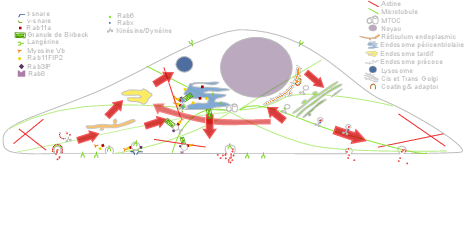Section: Application Domains
Biological pilot models: Birbeck granule and Melanosome biogenesis
In the past recent years, research carried at UMR 144 CNRS-Institut Curie (“Space Time imaging of Endomembranes and organelles Dynamics” team) contributed to a better understanding of the intracellular compartimentation of specialized model cells such as melanocytes and Langerhans cells, the components and structural events involved in the biogenesis of their specialized organelles: melanosomes and Birbeck granules, respectively. These studies have started to highlight: i/ multiple sorting and structural events involved in the biogenesis of these organelles; ii/ complexity of the endo-melanosomal network of these highly specialized cells; iii/ complex molecular architecture organizing and coordinating their dynamics; iv/ intracellular transport steps affected in genetic diseases, among which the Hermansky Pudlak syndrome (HPS) or involved in viral infection (HIV and Langerin in Langerhans cells).
In this context, the central aim of serpico is to understand how the different machineries of molecular components involved are interconnected and coordinated to generate such specialized structures. We need to address the following topics:
-
developing new bioimaging approaches to observe and statistically analyze such coordinated dynamics in live material;
-
correlating this statistically relevant spatiotemporal organization of protein networks with the biological architectures and at the ultrastructural level;
-
modeling intracellular transport of those reference biological complex systems and proposing new experimental plans in an iterative and virtuous circle;
-
managing and analyzing the workflow of image data obtained along different multidimensional microscopy modalities.
These studies are essential to unravel the complexity of the endomembrane system and how different machineries evolve together (e.g. see Fig. 1 ). They help to control cell organization and function at different scales through an integrative workflow of methodological and technological developments.
At long term, these studies will shed light on the cellular and molecular mechanisms underlying antigen presentation, viral infection or defense mechanisms, skin pigmentation, the pathogenesis of hereditary genetic disorders (lysosomal diseases, immune disorders) and on the mechanisms underlying cell transformation. Our methodological goal is also to link dynamics information obtained through diffraction limited light microscopy, eventually at a time regime compatible with live cell imaging. The overview of ultrastructural organization will be achieved by complementary electron microscopical methods. Image visualization and quantitative analysis are of course important and essential issues in this context.



